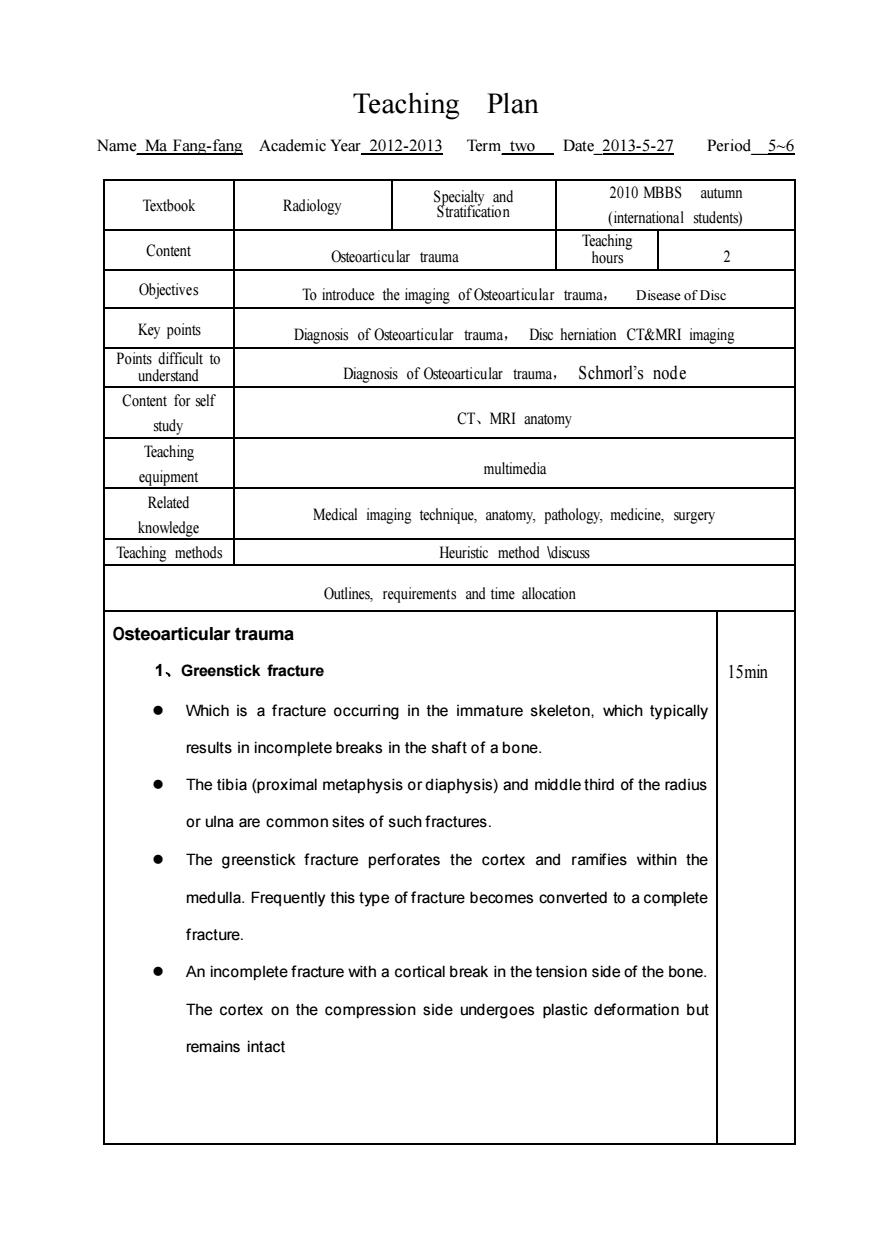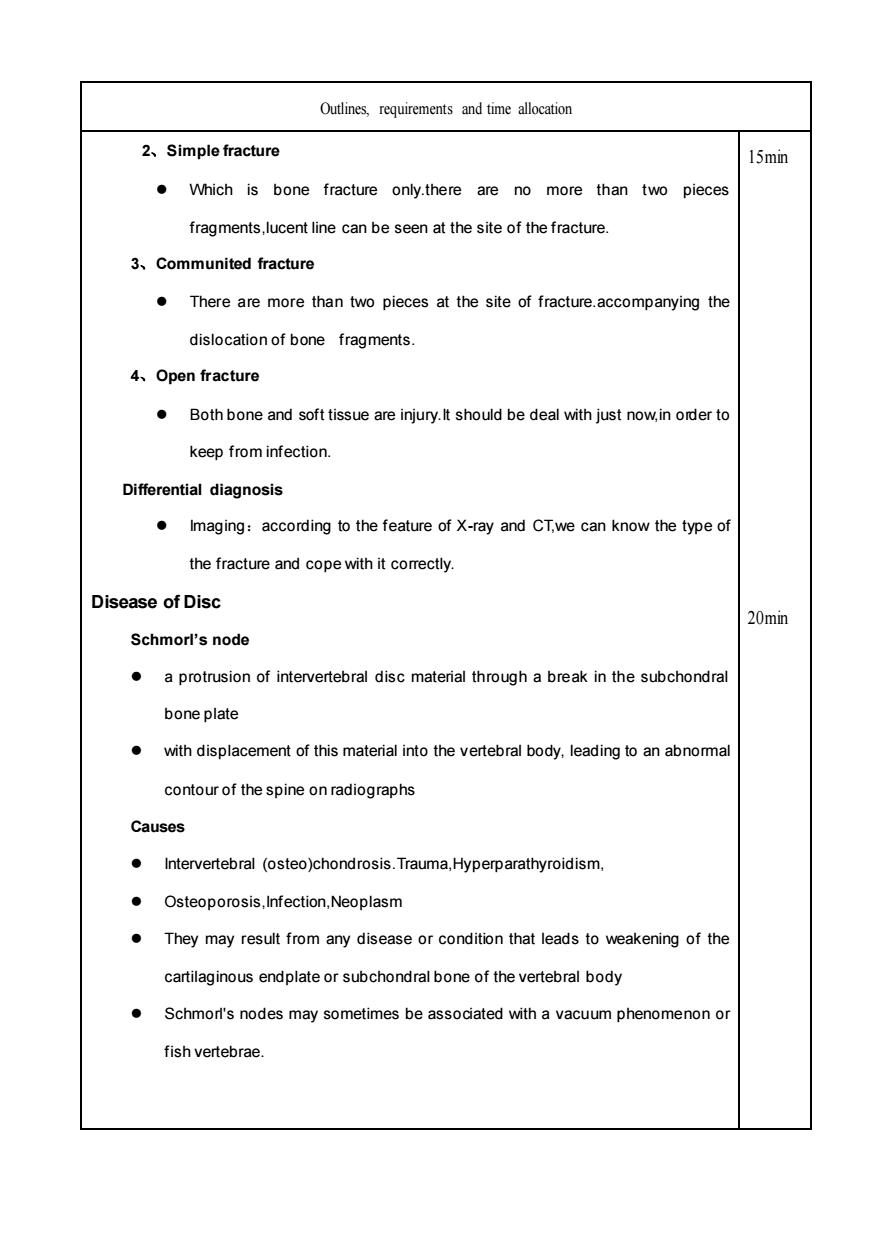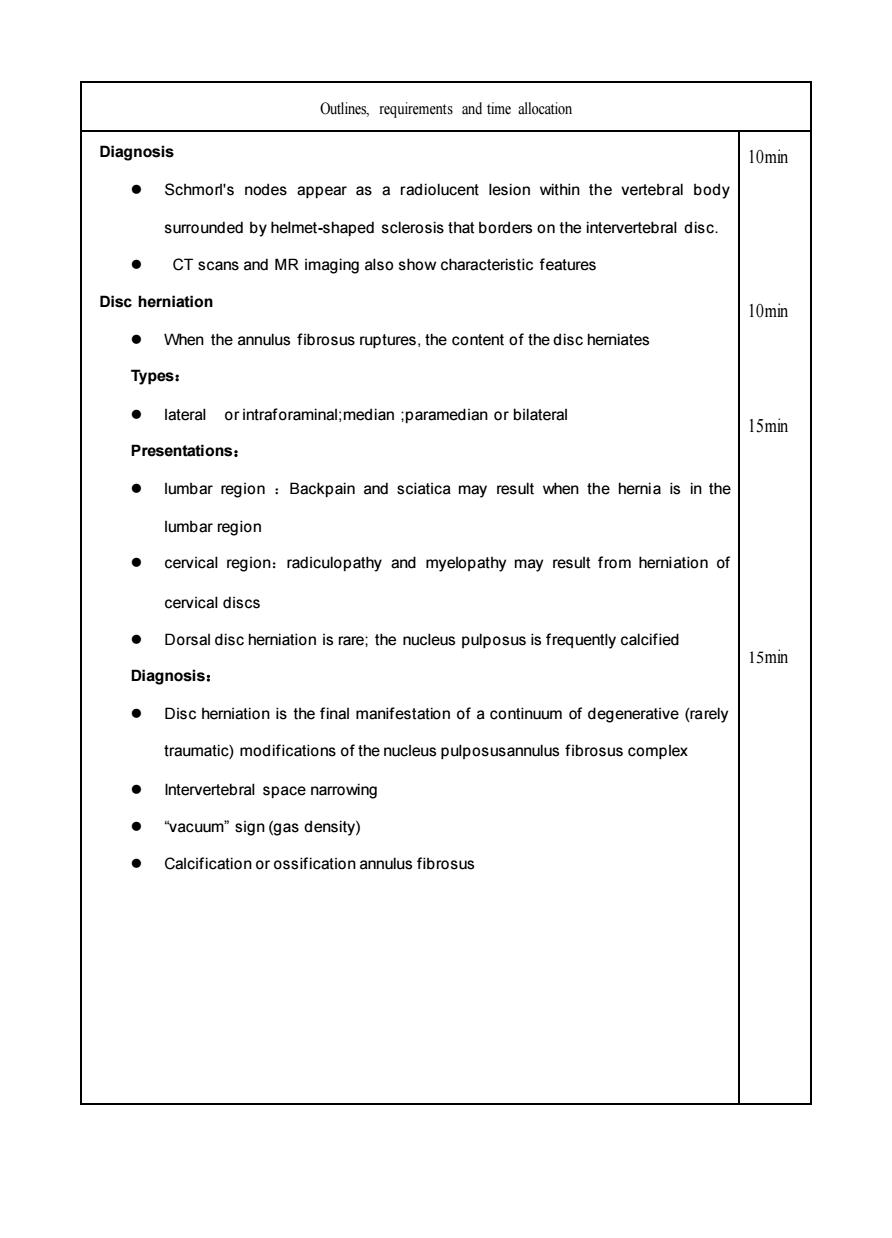
Teaching Plan Name_Ma Fang-fang Academic Year_2012-2013 Term two Date 2013-5-27 Period 5-6 2010 MBBS autumn Textbook Radiology a (students) Content Osteoarticular trauma 2 Objectives To introduce the imaging of Osteoarticular trauma,Disease of Disc Key points Diagnosis of Osteoarticular trauma,Disc hemiation CT&MRI imaging Pontsiff to unders Diagnosis of Osteoarticular trauma,Schmorl's node Content for self study CT、MRI anatomy Teaching equipment multimedia Related knowledge Medical imaging technique,anatomy,pathology,medicine.urgery Teaching methods Heuristic method ldiscuss Outlines,requirements and time allocation Osteoarticular trauma 1.Greenstick fracture 15min Which is a fracture occurring in the immature skeleton.which typically results in incomplete breaks in the shaft of a bone. 。 The tibia(proximal metaphysis ordiaphysis)and middle third of the radius or ulna are common sites of such fractures. .The greenstick fracture perforates the cortex and ramifies within the medulla.Frequently this type of fracture becomes converted to a complete fracture. An incomplete fracture with a cortical break in the tension side of the bone. The cortex on the compression side undergoes plastic deformation but remains intact
Teaching Plan Name_Ma Fang-fang Academic Year_2012-2013 Term_two Date_2013-5-27 Period_5~6 Textbook Radiology Specialty and Stratification 2010 MBBS autumn (international students) Content Osteoarticular trauma Teaching hours 2 Objectives To introduce the imaging of Osteoarticular trauma, Disease of Disc Key points Diagnosis of Osteoarticular trauma, Disc herniation CT&MRI imaging Points difficult to understand Diagnosis of Osteoarticular trauma, Schmorl’s node Content for self study CT、MRI anatomy Teaching equipment multimedia Related knowledge Medical imaging technique, anatomy, pathology, medicine, surgery Teaching methods Heuristic method \discuss Outlines, requirements and time allocation Osteoarticular trauma 1、Greenstick fracture ⚫ Which is a fracture occurring in the immature skeleton, which typically results in incomplete breaks in the shaft of a bone. ⚫ The tibia (proximal metaphysis or diaphysis) and middle third of the radius or ulna are common sites of such fractures. ⚫ The greenstick fracture perforates the cortex and ramifies within the medulla. Frequently this type of fracture becomes converted to a complete fracture. ⚫ An incomplete fracture with a cortical break in the tension side of the bone. The cortex on the compression side undergoes plastic deformation but remains intact 15min

Outlines requirements and time allocation 2、Simple fracture 15min .Which is bone fracture only there are no more than two pieces fragments,lucent line can be seen at the site of the fracture. 3.Communited fracture There are more than two pieces at the site of fracture.accompanying the dislocation of bone fragments 4、Open fracture Both bone and soft tissue are injury.It should be deal with just now.in oder to keep from infection. Differential diagnosis Imaging:according to the feature of X-ray and CTwe can know the type of the fracture and cope with it comrectly. Disease of Disc 20min Schmorl's node a protrusion of intervertebral disc material through a break in the subchondra bone plate with displacement of this material into the vertebral body.leading to an abnomma contour of the spine on radiographs Causes Intervertebral (osteo)chondrosis.Trauma.Hyperparathyroidism. Osteoporosis,Infection,Neoplasm They may result from any disease or condition that leads to weakening of the cartilaginous endplate or subchondral bone of the vertebral body Schmorl's nodes may sometimes be associated with a vacuum phenomenono fish vertebrae
Outlines, requirements and time allocation 2、Simple fracture ⚫ Which is bone fracture only.there are no more than two pieces fragments,lucent line can be seen at the site of the fracture. 3、Communited fracture ⚫ There are more than two pieces at the site of fracture.accompanying the dislocation of bone fragments. 4、Open fracture ⚫ Both bone and soft tissue are injury.It should be deal with just now,in order to keep from infection. Differential diagnosis ⚫ Imaging:according to the feature of X-ray and CT,we can know the type of the fracture and cope with it correctly. Disease of Disc Schmorl’s node ⚫ a protrusion of intervertebral disc material through a break in the subchondral bone plate ⚫ with displacement of this material into the vertebral body, leading to an abnormal contour of the spine on radiographs Causes ⚫ Intervertebral (osteo)chondrosis.Trauma,Hyperparathyroidism, ⚫ Osteoporosis,Infection,Neoplasm ⚫ They may result from any disease or condition that leads to weakening of the cartilaginous endplate or subchondral bone of the vertebral body ⚫ Schmorl's nodes may sometimes be associated with a vacuum phenomenon or fish vertebrae. 15min 20min

Outlines,requirements and time allocation Diagnosis 10min Schmorl's nodes appear as a radiolucent lesion within the vertebral body sumounded by helmet-shaped sclerosis that borders on the intervertebral disc CT scans and MR imaging also show characteristic features Disc herniation 10min When the annulus fibrosus ruptures.the content of the disc hemiates Types: lateral orintraforaminal:median :paramedian or bilateral 15min Presentations: .lumbar region:Backpain and sciatica may result when the hemia is in the lumbar region cervical region:radiculopathy and myelopathy may result from hemiation of cervical discs Dorsal disc hemiation is rare:the nucleus pulposus is frequently calcified 15min Diagnosis: Disc hemiation is the final manifestation of a continuum of degenerative(rarely traumatic)modifications of the nucleus pulposusannulus fibrosus complex Intervertebral space narrowing .vacuum"sign(gas density) Calcification or ossification annulus fibrosus
Outlines, requirements and time allocation Diagnosis ⚫ Schmorl's nodes appear as a radiolucent lesion within the vertebral body surrounded by helmet-shaped sclerosis that borders on the intervertebral disc. ⚫ CT scans and MR imaging also show characteristic features Disc herniation ⚫ When the annulus fibrosus ruptures, the content of the disc herniates Types: ⚫ lateral or intraforaminal;median ;paramedian or bilateral Presentations: ⚫ lumbar region :Backpain and sciatica may result when the hernia is in the lumbar region ⚫ cervical region:radiculopathy and myelopathy may result from herniation of cervical discs ⚫ Dorsal disc herniation is rare; the nucleus pulposus is frequently calcified Diagnosis: ⚫ Disc herniation is the final manifestation of a continuum of degenerative (rarely traumatic) modifications of the nucleus pulposusannulus fibrosus complex ⚫ Intervertebral space narrowing ⚫ “vacuum” sign (gas density) ⚫ Calcification or ossification annulus fibrosus 10min 10min 15min 15min